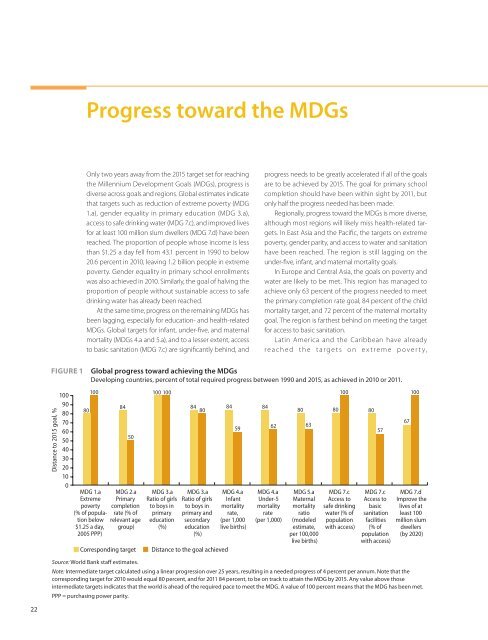rural-urban dynamics_report.pdf - Khazar University
rural-urban dynamics_report.pdf - Khazar University
rural-urban dynamics_report.pdf - Khazar University
You also want an ePaper? Increase the reach of your titles
YUMPU automatically turns print PDFs into web optimized ePapers that Google loves.
Progress toward the MDGs<br />
Only two years away from the 2015 target set for reaching<br />
the Millennium Development Goals (MDGs), progress is<br />
diverse across goals and regions. Global estimates indicate<br />
that targets such as reduction of extreme poverty (MDG<br />
1.a), gender equality in primary education (MDG 3.a),<br />
access to safe drinking water (MDG 7.c), and improved lives<br />
for at least 100 million slum dwellers (MDG 7.d) have been<br />
reached. The proportion of people whose income is less<br />
than $1.25 a day fell from 43.1 percent in 1990 to below<br />
20.6 percent in 2010, leaving 1.2 billion people in extreme<br />
poverty. Gender equality in primary school enrollments<br />
was also achieved in 2010. Similarly, the goal of halving the<br />
proportion of people without sustainable access to safe<br />
drinking water has already been reached.<br />
At the same time, progress on the remaining MDGs has<br />
been lagging, especially for education- and health-related<br />
MDGs. Global targets for infant, under-five, and maternal<br />
mortality (MDGs 4.a and 5.a), and to a lesser extent, access<br />
to basic sanitation (MDG 7.c) are significantly behind, and<br />
progress needs to be greatly accelerated if all of the goals<br />
are to be achieved by 2015. The goal for primary school<br />
completion should have been within sight by 2011, but<br />
only half the progress needed has been made.<br />
Regionally, progress toward the MDGs is more diverse,<br />
although most regions will likely miss health-related targets.<br />
In East Asia and the Pacific, the targets on extreme<br />
poverty, gender parity, and access to water and sanitation<br />
have been reached. The region is still lagging on the<br />
under-five, infant, and maternal mortality goals.<br />
In Europe and Central Asia, the goals on poverty and<br />
water are likely to be met. This region has managed to<br />
achieve only 63 percent of the progress needed to meet<br />
the primary completion rate goal, 84 percent of the child<br />
mortality target, and 72 percent of the maternal mortality<br />
goal. The region is farthest behind on meeting the target<br />
for access to basic sanitation.<br />
Latin America and the Caribbean have already<br />
reached the targets on extreme poverty,<br />
FIGURE 1<br />
Distance to 2015 goal, %<br />
100<br />
90<br />
80<br />
70<br />
60<br />
50<br />
40<br />
30<br />
20<br />
10<br />
0<br />
80<br />
Global progress toward achieving the MDGs<br />
Developing countries, percent of total required progress between 1990 and 2015, as achieved in 2010 or 2011.<br />
100 100 100<br />
MDG 1.a<br />
Extreme<br />
poverty<br />
(% of population<br />
below<br />
$1.25 a day,<br />
2005 PPP)<br />
84<br />
50<br />
MDG 2.a<br />
Primary<br />
completion<br />
rate (% of<br />
relevant age<br />
group)<br />
Corresponding target<br />
MDG 3.a<br />
Ratio of girls<br />
to boys in<br />
primary<br />
education<br />
(%)<br />
84 80<br />
84<br />
MDG 3.a<br />
Ratio of girls<br />
to boys in<br />
primary and<br />
secondary<br />
education<br />
(%)<br />
Distance to the goal achieved<br />
59<br />
MDG 4.a<br />
Infant<br />
mortality<br />
rate,<br />
(per 1,000<br />
live births)<br />
84<br />
62<br />
MDG 4.a<br />
Under-5<br />
mortality<br />
rate<br />
(per 1,000)<br />
80<br />
63<br />
MDG 5.a<br />
Maternal<br />
mortality<br />
ratio<br />
(modeled<br />
estimate,<br />
per 100,000<br />
live births)<br />
80<br />
100<br />
MDG 7.c<br />
Access to<br />
safe drinking<br />
water (% of<br />
population<br />
with access)<br />
80<br />
57<br />
MDG 7.c<br />
Access to<br />
basic<br />
sanitation<br />
facilities<br />
(% of<br />
population<br />
with access)<br />
67<br />
100<br />
MDG 7.d<br />
Improve the<br />
lives of at<br />
least 100<br />
million slum<br />
dwellers<br />
(by 2020)<br />
Source: World Bank staff estimates.<br />
Note: Intermediate target calculated using a linear progression over 25 years, resulting in a needed progress of 4 percent per annum. Note that the<br />
corresponding target for 2010 would equal 80 percent, and for 2011 84 percent, to be on track to attain the MDG by 2015. Any value above those<br />
intermediate targets indicates that the world is ahead of the required pace to meet the MDG. A value of 100 percent means that the MDG has been met.<br />
PPP = purchasing power parity.<br />
22

















